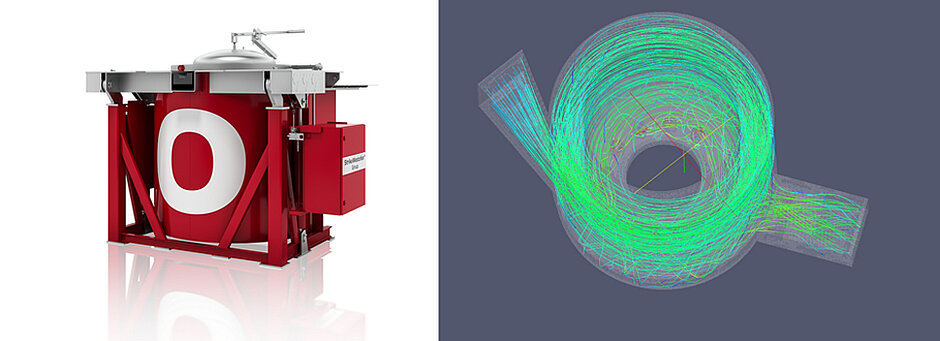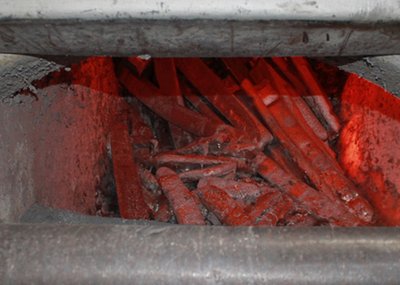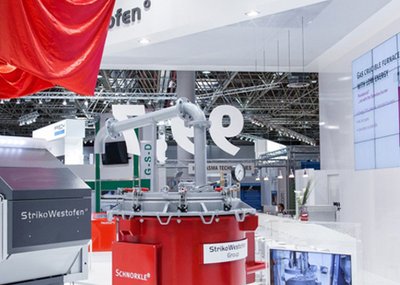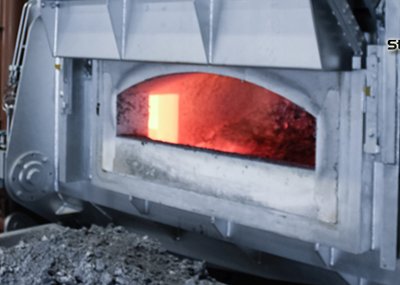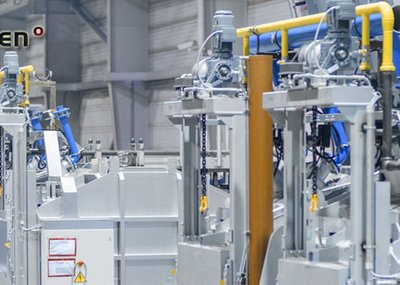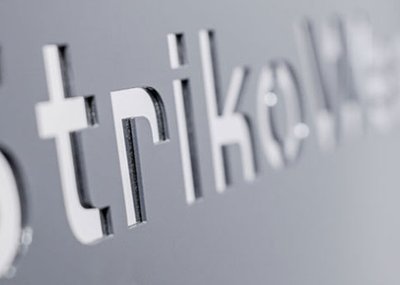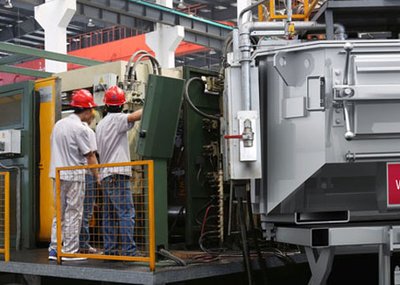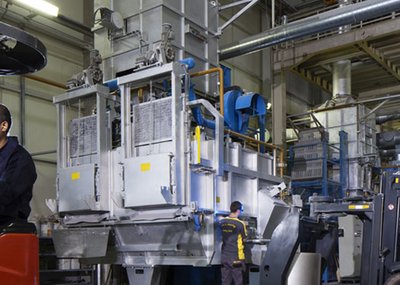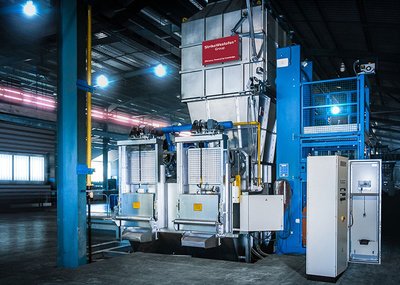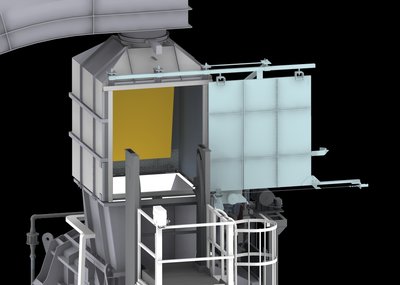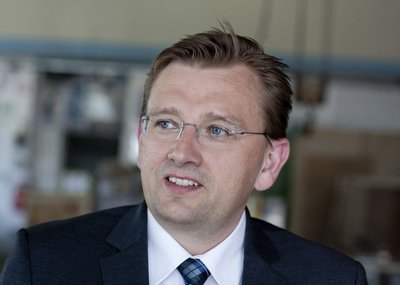With a wide range of innovations, StrikoWestofen helps foundries to improve results as well as occupational safety and efficiency
The requirements which production technology has to meet rise in step with the demand for new and more numerous cast aluminium parts. For foundries, StrikoWestofen presents the new “StrikoMelter BigStruc”, which can remelt extremely thin-walled material as well as bulky large-volume material with minimum metal loss and the lowest possible energy consumption. At the heart of the new dosing furnace technology in 2015 is the “Westomat Plus+” with its new technology and its extraordinary design. For a short time now, the pneumatic filling system “Schnorkle” has allowed the safe, closed, temperature-stable transport of liquid metal. In addition, modern porous burner technology guarantees measurable savings for the new gas crucible furnaces.
The continuing trend towards lightweight design also increases the demands made on cast aluminium parts and the relevant production processes. The extremely wide range of requirements makes new solutions necessary, from component development to production. StrikoWestofen is dedicated to providing and constantly improving products and solutions which support these requirements.
Inner and outer values: the new Westomat Plus+
The new design of the “Westomat Plus+” reduces the necessary installation space resources: the Westomat Plus+ 1200 S now fits into the footprint of the Westomat 900 SL. This allows higher capacities without increasing the space requirements. The heat losses caused by thermal radiation also decrease as a result of the reduced furnace surface. At the same time, the new overhead heating system allows easy replacement from above, so that no additional space is required at the sides. The optimized pneumatic dosing system makes the Westomat Plus+ even more reliable and easy to maintain. As a result of this product development, the new Westomat Plus+ only requires one third of the energy consumed by ladle systems, and its metal loss of 0.06 percent is only about 20 percent of the usually figure. At the same time, the Westomat Plus+ offers an availability of up to 98 percent.
The ProDos 3 control software allows the virtually exact determination of the dosing weight with the help of the feed pressure curve. This increases the dosing precision of the Westomat Plus+ to ±1 percent, which corresponds with a further optimization of around 33 percent. In addition, the ProDos 3 control unit has a new operating concept: besides an initial overview image, the intuitive user interface provides two further levels only – one for the basic settings of the Westomat and one for all maintenance functions. This means that all requirements of pressure die-casting can be parameterized individually within a short time. During initial commissioning, an assistant makes child’s play of setting up the system: the dosing weight can now be entered directly, and it is no longer necessary to measure various reference weights. The new malfunction notice concept provides an overview of current and past malfunctions. Thus, the control documents not only each change, but also any errors which the system may have eliminated by itself. The integrated web server 4.0 makes it even more user-friendly. This allows all relevant information to be integrated into the company network and conveniently accessed and evaluated from your office desk. The pressure in the furnace chamber, the temperature or dosing weight as well as all malfunction notices and process data from the last 350 cycles can be viewed and processed. High safety standards prevent intervention from outside. As an alternative to ProDos 3, the new PLCDos control is particularly suitable for implementing numerous special functions in pressure die-casting and gravity die-casting. Like ProDos 3, it provides a straightforward operation and malfunction notice concept and makes it easier to implement customer-specific requirements. Protected basic functions for dosing operation maintain a high safety standard at all times. All innovations included in the optimized ProDos 3 control are also available for the dosing control system PLCDos.
Schnorkle: the safe way
From now on, “Schnorkle” ensures the safe transport of the melt from the melting aggregate to the dosing or holding furnace. This closed transport system is filled directly at the melting furnace. After the pressure-tight semi-cover has been closed, the system guarantees extremely safe transport with no contact between melt and atmosphere. By applying pressure to the closed transfer ladle, the melt is then fed directly into the filling funnel of the Westomat, using a transfer pipe. This ensures a uniform flow rate and guarantees reproducible process flows after certain basic settings have been made. Thanks to Schnorkle, it is no longer necessary to tip casting ladles above the filling funnel using a lift truck. As a result, the Westomat can now be used in low factory buildings too. The minimal contact between melt and atmosphere ensures an improved metal quality. Degasding the melt using impellers is also directly possible in Schnorkle. In total, Schnorkle provides increased automation and improves safety for persons and process flows. It keeps the temperature of the melt stable, thus reducing the energy consumption of the foundry.
The new StrikoMelter BigStruc melts anything
The “StrikoMelter BigStruc” for structural components is also the champion of energy and material efficiency: the BigStruc is suitable for melting bulky and yet very thin-walled returns as well as extremely small-sized material. Thanks to internal heat recovery, the cast parts are preheated without direct contact with the flames while still in the upper part of the shaft and melted at the foot of it. The hot metal then flows directly from the melting bridge into the holding chamber. The special shaft design of the BigStruc accepts returns with an area of up to 2.5 m2. The height of the shaft remains unchanged in comparison with the standard StrikoMelter.
Bulky and large-volume parts have a larger void volume and a low bulk density. To be nevertheless able to recover the energy of the hot exhaust gases, it is necessary to increase the time for which the hot gases remain in the upper part of the shaft - the integrated preheating zone. The purpose of the “hot gas baffle” is to keep the shaft of the BigStruc closed after the charging process. This achieves better preheating of the charging material and prevents the energy from escaping unused. In addition, the highly heat-resistant hot gas baffle shortens the melting-free process by around 20 percent, thus increasing the total energy efficiency of the system by about five percent. The optimum filling of the shaft is guaranteed thanks to an integrated laser scanner system. This monitors the filling level of the closed shaft at all times. In this way, the charging material is refilled at the most energy-efficient time imaginable, and the best possible heat recovery is ensured by an optimal shaft filling process. At the same time, this automates the charging cycles and increases operational safety.
Various additional options allow the energy efficiency of the StrikoMelter shaft melting furnaces to be increased still more – for example by means of dual energy recovery. Here the waste heat from the melting process is used to preheat the metal in the shaft while some of the exhaust gases are directed through a recuperator to preheat the combustion air to 150 °C. This reduces the gas consumption necessary for the combustion process by four to five percent. When operated with the shaft half-filled or during the melting-free process, even higher energy savings can be achieved. The combustion air preheating system can be used in an economically efficient way at a melting performance of 4 t/h or more.
Oxygen content and excess air in the furnace atmosphere increase the energy requirements and promote metal oxidation and corundum formation. The new option of a near-stoichiometric burner setting minimizes both because it allows you to set the ideal ratio of air and combustion gas. Also newly available are self-sealing lift swing doors which considerably reduce the heat losses in melting and holding operation. As the new door concept rules out the entrance of false air, it also contributes towards reducing corundum formation in the furnace. The geometry of the new door design also facilitates maintenance work such as cleaning and seal replacement.
Flameless gas heating – crucible furnaces are now becoming economical
The new crucible furnaces with porous burner technology achieve an up to 20 percent increase in energy efficiency compared with conventional crucible furnaces. These high energy savings are a result of the optimal pre-mixing of gas and air and the resulting near-stoichiometric combustion. They are optimally suitable for melting and holding aluminium and magnesium. Flameless burners heat the silicon carbide and steel crucible uniformly without causing any hot spots. This is an important contribution to a distinctly longer service life of the crucibles. Also, the low flow speed ensures that the hot gases remain at the crucible for longer, thus allowing optimal utilization of energy. The exhaust outlet is located at the bottom of the furnace, providing room for a continuous working platform to facilitate access for loading and cleaning purposes.
Efficient, safe working in everyday foundry operation is ensured here too by a newly developed quick-connect coupling for steel and ceramic pipes used to transport liquid metal. This is because attachments and pipes often have to be disconnected during the feeding and dosing of the melt. The quick-connect coupling allows you to change the system components in about two minutes – even in the hot state at 680 degrees Celsius without having to laboriously open screw connections on flanges. As it is no longer necessary to cool the pipes, production only needs to be interrupted for a very short time.
For lead foundries, StrikoWestofen now offers a new stirrer which can be used in crucibles and furnaces for stirring in metal chips. It generates a local vortex into which the charge material is constantly fed. This current immediately pulls the newly fed material under the surface of the bath, melts it rapidly and spreads it evenly throughout the bath. This prevents temperature reductions and improves the heat transitions on the walls of crucibles and furnaces, thus ensuring a stable temperature of the melt at all times. In addition, the small bath surface keeps oxidation low.
Modernizing and retrofitting
High-quality products are convincing solutions due to their long service life. This is why, in addition to its newly developed innovations, StrikoWestofen offers numerous retrofits for bringing installed equipment up to the latest standards in terms of efficiency. Besides optimization using hot gas baffles and lasers to monitor the filling level in the shaft, an automatic tapping valve and a triple bath filling level monitoring system ensure improved operational and occupational safety. Also, refractory relining in OEM quality can reduce the consumption of natural gas by up to 40 percent as well as improving melting performance and melting process. The overhaul and replacement of charging devices also optimizes the procedures and increases the melting performance. In addition, StrikoWestofen has expanded its range of seminars and training courses in order to show staff the optimum way of operating not only state-of-the-art technology but also long-established technology.
Partner
Euroguss 2016
Foundry Corporate News
Topic Pressure Die Casting
More innovations than ever in aluminium casting
Reading time: min
[3]

